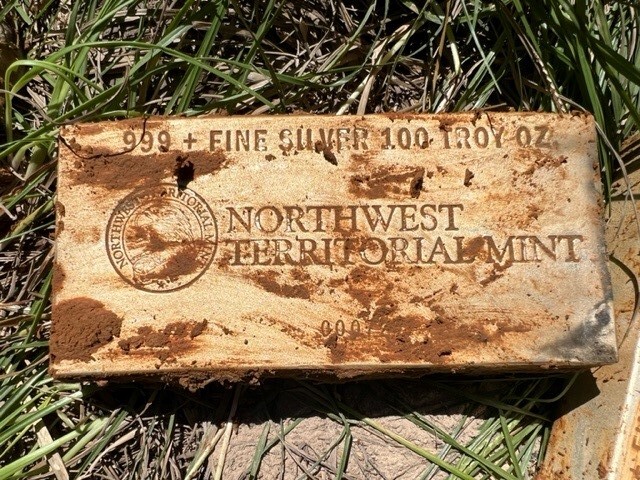Buried for 10 years, Stagecoach Robbery Treasure (Silver Bars), recovered in Texas, reported by Houston Metal Detecting Services. The recovery of 1300 ounces of .999 pure silver bars. In September 1878, at Canyon Springs Stagecoach station, near Deadwood, Dakota Territory, an infamous outlaw known as Lame Johnny, concocted a scheme to steal the payroll and gold from the Homestake Mine. The mine sent its valuables aboard an armored stage known as the “Monitor”, specially built for bullion and payroll shipments, complete with loopholes for guns and the treasure box bolted to the floor. Called Lame Johnny because of a deformed foot, he’d tried his hand at living legit, but cowboying wasn’t in his cards. He headed to Deadwood and gained election as a deputy, but honest work didn’t appeal to him. He tried prospecting, then got a job with the Homestake Mine as a bookkeeper. Fired when somebody recognized him from his horse rustling days in Texas, he escaped and returned to a life of crime. He formed up a gang of at least four like-minded men, and they quickly gained a reputation as horse thieves and stagecoach bandits. Because of his experience with the company, he knew the stage schedule, and by the time it pulled into the Canyon Springs station, the attendant was already incapacitated. Caught off guard, the occupants of the stage were fired upon, one killed and two critically injured. After shooting back at the bandits, one guard ran for help. The gang dragged the Monitor into the trees and apparently had little trouble prying open the supposedly theft-proof treasure box and transferring the contents, (see list below) loading the loot into a wagon in about two hours. The gang then split up and disappeared into the hills, heading east into the canyons. A considerable treasure was the shipment on the Monitor for this trip – including three gold ingots, 1056 ounces of gold dust, 1300 ounces of silver bars and nuggets, $500 in diamonds, $500 in jewelry, and $2000 in currency a total value of $27,075 at that time. OK, actually we were contacted by a property owner whose family's estate was up for sale. It was known to members of the family that their grandfather had cashed in his 401K years back in fear of a financial collapse in the USA. Family members had been told that grandpa had purchased some form of silver and buried it on his homestead. Our clients had a general idea of where they believed the hoard of silver may have been buried, but after numerous exhaustive efforts of digging holes and metal detecting for the silver, they surrendered their efforts. Our clients provided a roadmap to a remote location in Texas, with a hand-drawn treasure map of where they believed Grandpa had buried the silver. The type and amount of silver were unknown but believed to be equivalent to the amount of his 401K. Our clients informed us if we were up to the task, we needed to travel prepared, as the location had no running water and cellular service was nonexistent. Following the treasure map, we made our way into some remote stretches of the Texas countryside. Being 90+ degrees we knew this was going to be a difficult task and prepared some essential gear for the task. Upon our arrival, I was pretty sure I saw a sasquatch running through the neighboring tree line. But we pushed forward and arrived at the X mark as illustrated on the Treasure Map. As we scouted the area, we could see where our clients had spent time digging numerous holes in the area, they had described to us. Our clients had indicated they had purchased some academy sport metal detectors and found only small nails and screws. Carl and I reviewed the treasure map one last time and set out to conduct our search. We established our search sectors and set about clearing every identifiable target. The sun and heat were brutal, but after a few hours, we sterilized the search area of all identifiable metallic targets. Following that, we spent another hour working beyond our defined search area, clearing all targets as we went. It was time for our final pass, we set out with much larger search coils and stronger machines hoping to penetrate deeper into the earth, ensuring we had not walked past the buried treasure. With the detectors set at maximum strength, we detected a signal believed to be beyond 12-14 inches in depth, it was a very faint signal but warranted an examination. After removing the first 12-14 inches of soil the detector still indicated the target was at least another 12-14 inches down in depth. This was unique, as no other target up to that point was at this depth. removal of another 12-14 inches and the detector basically said keep digging. Guess the first contact with the target was at about 28-30 inches when I stuck a solid mass with the tip of the shovel. I immediately saw water discharge from the unknown structure. I had assumed, I had stuck some type of sewer line. That thought only lasted for a moment as I pulled my head out from the hole and looked around. It was clear; it was something else. I excavated around the mass and identified that this was some form of a glass container. Carl and I excavated three large pickle jars over the next few hours and accounted for 10 100 troy-ounce bars, and 30 10 troy-ounce bars of silver. The contents of silver in the three jars were consistent with the 401K from that time frame, confirming the triangle pattern of these jars in the ground was the total cache. It had been reported that Grandpa may have used a tractor and mechanical auger (post-hole digger) to bury these jars. We felt very confident after the recovery that this was factual, unlike other elements in this story. Have a great day, I know we did! #houstonmetaldetectingservices





















